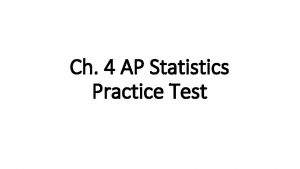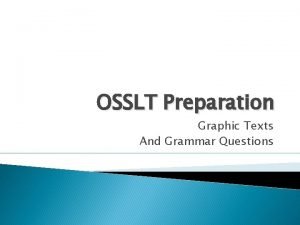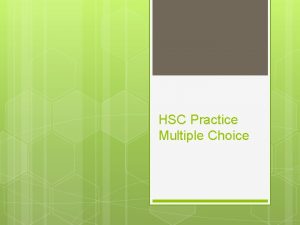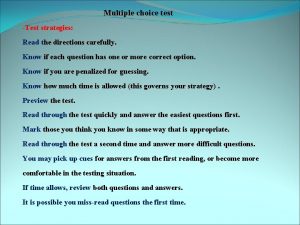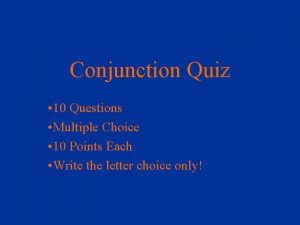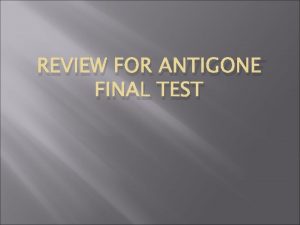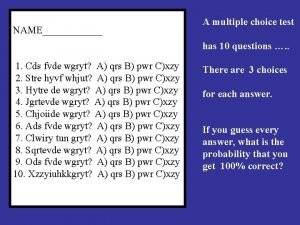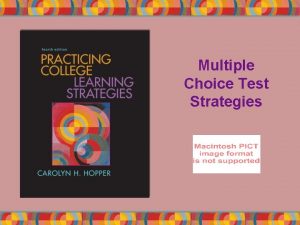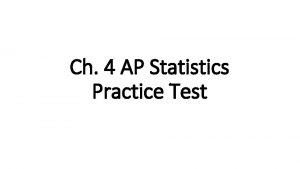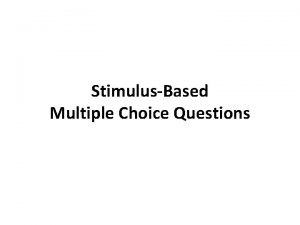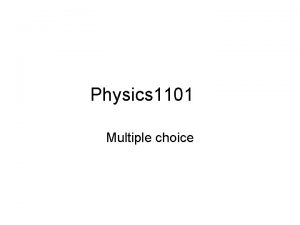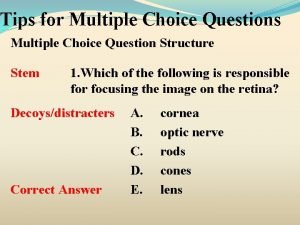Ch 11 AP Statistics Practice Test Multiple Choice
















- Slides: 16

Ch. 11 AP Statistics Practice Test

Multiple Choice

Question 1: A chi-square test is used to test whether a 0 to 9 spinner is “fair” (that is, the outcomes are all equally likely). The spinner is spun 100 times, and the results are recorded. The degrees of freedom for the test will be a) 8 Answer: (B) since df = b) 9 number of categories – 1 = c) 10 10 – 1 = 9 d) 99 e) None of these.

Answer: (C) since this is a Chi-Square Test for Homogeneity Exercises #2 and 3 refer to the following setting: Recent revenue shortfalls in a midwestern state led to a reduction in the state budget for higher education. To offset the reduction, the largest state university proposed a 25% tuition increase. It was determined that such an increase was needed simply to compensate for the lost support from the state. Separate random samples of 50 freshmen, 50 sophomores, 50 juniors, and 50 seniors from the university were asked whether they were strongly opposed to the increase, given that it was the minimum increase necessary to maintain the university’s budget at current levels. Here are the results. Which hypotheses would be appropriate for performing a chi-square test? a) The null hypothesis is that the closer students get to graduation, the less likely they are to be opposed to tuition increases. The alternative is that how close students are to graduation makes no difference in their opinion. b) The null hypothesis is that the mean number of students who are strongly opposed is the same for each of the 4 years. The alternative is that the mean is different for at least 2 of the 4 years. c) The null hypothesis is that the distribution of student opinion about the proposed tuition increase is the same for each of the 4 years at this university. The alternative is that the distribution is different for at least 2 of the 4 years. d) The null hypothesis is that year in school and student opinion about the tuition increase in the sample are independent. The alternative is that these variables are dependent. e) The null hypothesis is that there is an association between year in school and opinion about the tuition increase at this university. The alternative hypothesis is that these variables are not associated. Question 2:

Question 3: Answer: (E) Exercises #2 and 3 refer to the following setting: Recent revenue shortfalls in a midwestern state led to a reduction in the state budget for higher education. To offset the reduction, the largest state university proposed a 25% tuition increase. It was determined that such an increase was needed simply to compensate for the lost support from the state. Separate random samples of 50 freshmen, 50 sophomores, 50 juniors, and 50 seniors from the university were asked whether they were strongly opposed to the increase, given that it was the minimum increase necessary to maintain the university’s budget at current levels. Here are the results. The conditions for carrying out the chi-square test in exercise #2 are I. Independent random samples from the populations of interest. II. All expected counts are at least 5. III. The population sizes are at least 10 times the sample sizes. Which of the conditions is (are) satisfied in this case? a) I only b) II only c) I and II only d) II and III only e) I, II, and III

Question 4: •

Question 5: Answer: (C) since df = # of categories – 1 = 4 – 1 = 3 and using Table C We compute the value of the χ2 statistic to be 6. 58. Assuming that the conditions for inference are met, the Pvalue of our test is a) greater than 0. 20. b) between 0. 10 and 0. 20. c) between 0. 05 and 0. 10. d) between 0. 01 and 0. 05. e) less than 0. 01.

Question 6: The category that contributes the largest component to the χ2 statistic is a) White b) Black c) Hispanic d) Other e) The answer cannot be determined because this is only a sample.

Question 7: Answer: (B) since df = (# of rows – 1)(# of columns – 1) = (2 -1)(3 -1) = (1)(2) = 2 Exercises #7 to 10 refer to the following setting: All current-carrying wires produce electromagnetic (EM) radiation, including the electrical wiring running into, through, and out of our homes. High-frequency EM radiation is thought to be a cause of cancer. The lower frequencies associated with household current are generally assumed to be harmless. To investigate the relationship between current configuration and type of cancer, researchers visited the addresses of a random sample of children who had died of some form of cancer (leukemia, lymphoma, or some other type) and classified the wiring configuration outside the dwelling as either a high-current configuration (HCC) or a low-current configuration (LCC). Computer software was used to analyze the data. The output included the value χ2 = 0. 435. The appropriate degrees of freedom for the χ2 statistic is a) 1 b) 2 c) 3 d) 4 e) 5

Question 8: Answer: (A) since expected counts = (row total)(column total) / (table total) Exercises #7 to 10 refer to the following setting: All current-carrying wires produce electromagnetic (EM) radiation, including the electrical wiring running into, through, and out of our homes. High-frequency EM radiation is thought to be a cause of cancer. The lower frequencies associated with household current are generally assumed to be harmless. To investigate the relationship between current configuration and type of cancer, researchers visited the addresses of a random sample of children who had died of some form of cancer (leukemia, lymphoma, or some other type) and classified the wiring configuration outside the dwelling as either a high-current configuration (HCC) or a low-current configuration (LCC). Computer software was used to analyze the data. The output included the value χ2 = 0. 435. •

Question 9: Exercises #7 to 10 refer to the following setting: All current-carrying wires produce electromagnetic (EM) radiation, including the electrical wiring running into, through, and out of our homes. High-frequency EM radiation is thought to be a cause of cancer. The lower frequencies associated with household current are generally assumed to be harmless. To investigate the relationship between current configuration and type of cancer, researchers visited the addresses of a random sample of children who had died of some form of cancer (leukemia, lymphoma, or some other type) and classified the wiring configuration outside the dwelling as either a high-current configuration (HCC) or a low-current configuration (LCC). Computer software was used to analyze the data. The output included the value χ2 = 0. 435. Which of the following may we conclude, based on the test results? a) There is convincing evidence of an association between wiring configuration and the chance that a child will develop some form of cancer. b) HCC either causes cancer directly or is a major contributing factor to the development of cancer in children. c) Leukemia is the most common type of cancer among children. d) There is not convincing evidence of an association between wiring configuration and the type of cancer that caused the deaths of children in the study. e) There is convincing evidence that HCC does not cause cancer in children.

Question 10: Exercises #7 to 10 refer to the following setting: All current-carrying wires produce electromagnetic (EM) radiation, including the electrical wiring running into, through, and out of our homes. High-frequency EM radiation is thought to be a cause of cancer. The lower frequencies associated with household current are generally assumed to be harmless. To investigate the relationship between current configuration and type of cancer, researchers visited the addresses of a random sample of children who had died of some form of cancer (leukemia, lymphoma, or some other type) and classified the wiring configuration outside the dwelling as either a high-current configuration (HCC) or a low-current configuration (LCC). Computer software was used to analyze the data. The output included the value χ2 = 0. 435. A Type I error would occur if we found convincing evidence that a) HCC wiring caused cancer when it actually didn’t. b) HCC wiring didn’t cause cancer when it actually did. c) there is no association between the type of wiring and the form of cancer when there actually is an association. d) there is an association between the type of wiring and the form of cancer when there actually is no association. e) the type of wiring and the form of cancer have a positive correlation when they actually don’t.

Free-Response

Question 11: A large distributor of gasoline claims that 60% of all cars stopping at their service stations choose regular unleaded gas and that premium and supreme are each selected 20% of the time. To investigate this claim, researchers collected data from a random sample of drivers who put gas in their vehicles at the distributor’s service stations in a large city. The results were as follows: Carry out a test of the distributor’s claim at the 5% significance level.

Question 12: A study conducted in Charlotte, North Carolina, tested the effectiveness of three police responses to spouse abuse: (1) advise and possibly separate the couple, (2) issue a citation to the offender, and (3) arrest the offender. Police officers were trained to recognize eligible cases. When presented with an eligible case, a police officer called the dispatcher, who would randomly assign one of the three available treatments to be administered. There were a total of 650 cases in the study. Each case was classified according to whether the abuser was subsequently arrested within six months of the original incident. a. Explain the purpose of the random assignment in the design of this study. b. Construct a well-labeled graph that is suitable for comparing the effectiveness of the three treatments. c. State an appropriate pair of hypotheses for performing a chi-square test in this setting. d. Assume that all the conditions for performing the test in part (b) are met. The test yields χ2 = 5. 063 and a P-value of 0. 0796. Interpret this P-value in context. What conclusion should we draw from the study?

Question 13: In the United States, there is a strong relationship between education and smoking: well-educated people are less likely to smoke. Does a similar relationship hold in France? To find out, researchers recorded the level of education and smoking status of a random sample of 459 French men aged 20 to 60 years. The two-way table below displays the data. Is there convincing evidence of an association between smoking status and educational level among French men aged 20 to 60 years?
 Ap statistics chapter 7 test answer key
Ap statistics chapter 7 test answer key Ap stats practice test multiple choice
Ap stats practice test multiple choice Ap lit multiple choice tips
Ap lit multiple choice tips Osslt grammar practice with answers
Osslt grammar practice with answers Oedipus multiple choice questions
Oedipus multiple choice questions Tips for ap lang multiple choice
Tips for ap lang multiple choice Hsc multiple choice practice
Hsc multiple choice practice Oedipus rex mcq
Oedipus rex mcq Monstrous joy in the story of an hour
Monstrous joy in the story of an hour Multiple choice questions directions
Multiple choice questions directions Polynomials multiple choice test doc
Polynomials multiple choice test doc Who disturbed the watch of the elsinore guards
Who disturbed the watch of the elsinore guards Multiple choice questions on conjunctions
Multiple choice questions on conjunctions Math multiple choice test taking strategies
Math multiple choice test taking strategies Antigone open-ended questions
Antigone open-ended questions Multiple choice questions
Multiple choice questions Good choice or bad choice
Good choice or bad choice

